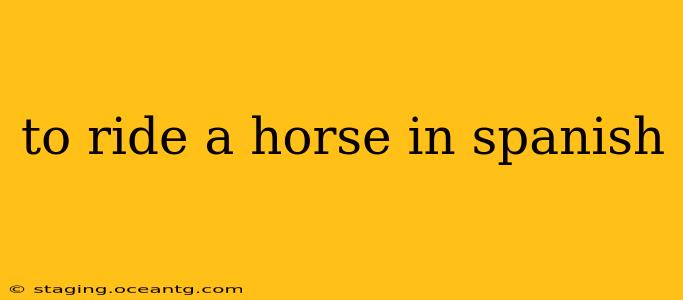Learning how to say "to ride a horse" in Spanish isn't just about knowing a single phrase; it's about understanding the nuances of the language and how different contexts require different expressions. This guide will delve into the various ways to express the concept of horseback riding in Spanish, ensuring you're equipped to use the most appropriate phrasing in any situation.
The most straightforward translation of "to ride a horse" in Spanish is montar a caballo. This is a widely understood and accepted phrase, perfect for most conversational situations.
How to Say "To Ride a Horse" in Different Contexts
While "montar a caballo" is versatile, the specific wording might subtly change depending on the context. Let's explore some variations:
1. What's the verb for "to ride a horse"?
The primary verb is montar. This verb means "to mount," "to ride," or "to climb," and when referring to horses, it implies the act of riding. You can use it with the preposition "a" followed by "caballo" (horse) to make the meaning explicit: montar a caballo.
2. How do you say "I ride a horse" in Spanish?
The translation depends on the tense. Here are a few examples:
- Present tense: Yo monto a caballo. (I ride a horse.)
- Past tense: Yo monté a caballo. (I rode a horse.)
- Future tense: Yo montaré a caballo. (I will ride a horse.)
You can easily substitute "yo" (I) with other pronouns like "él" (he), "ella" (she), "nosotros" (we), etc., to adjust the sentence to the subject.
3. Are there other ways to say "to ride a horse" in Spanish?
While less common, you might encounter other expressions depending on the region or the specific nuance you want to convey. For example, "andar a caballo" is sometimes used, although "montar a caballo" is more prevalent. "Andar a caballo" generally emphasizes the act of traveling on horseback, rather than the simple act of riding.
4. What's the difference between "montar a caballo" and "andar a caballo"?
The difference is subtle but important. Montar a caballo focuses on the act of getting on and riding a horse. Andar a caballo emphasizes the journey or travel undertaken while riding. Imagine someone saying, "I'm going to ride my horse across the country." Here, "andar a caballo" would be a more suitable translation than "montar a caballo," as the emphasis is on the journey.
5. How do you say "I am going to ride a horse" in Spanish?
This uses the "ir a" + infinitive construction: Voy a montar a caballo. (I am going to ride a horse.) This indicates a future intention.
Beyond the Basics: Enhancing Your Horse Riding Vocabulary
Learning to ride a horse opens up a whole new vocabulary. Here are some related terms that will enrich your understanding:
- Caballo: Horse (male)
- Yegua: Mare (female horse)
- Potro: Colt (young male horse)
- Potra: Filly (young female horse)
- Jinete: Horseman/Rider (male)
- Amazona: Horsewoman/Rider (female)
- Riendas: Reins
- Silla: Saddle
- Espuelas: Spurs
Mastering these phrases and vocabulary will enable you to speak confidently and accurately about horseback riding in Spanish, whether you're discussing a leisurely ride or a competitive event. Remember, the best way to learn is through practice and immersion. So saddle up (¡a montar!) and explore the world of equestrian vocabulary in Spanish!
